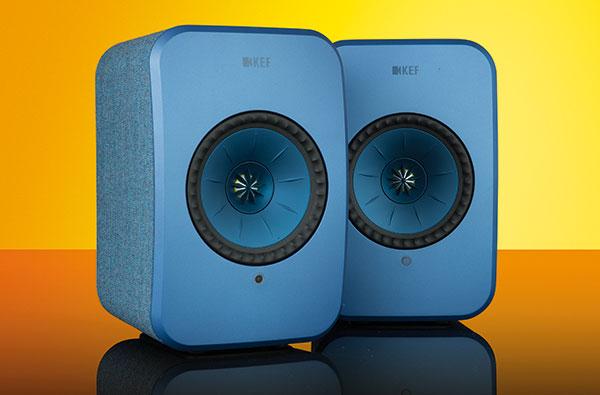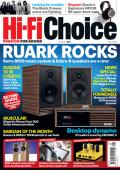KEF LSX

 Good ideas are usually and usefully scalable. This can mean zooming down as well as up or, in the case of KEF’s new LSX active wireless speaker system, both. Considerably more compact than the excellent £2,000 LS50 Wireless active loudspeaker system (HFC 433) from which the LSX takes many of its design and tech cues, it’s also half the price. Some commentators called the LS50 Wireless the future of hi-fi when it went on sale in 2016. Well, this is how that future unfolds. Step one: make it lighter, smaller, simpler and more affordable.
Good ideas are usually and usefully scalable. This can mean zooming down as well as up or, in the case of KEF’s new LSX active wireless speaker system, both. Considerably more compact than the excellent £2,000 LS50 Wireless active loudspeaker system (HFC 433) from which the LSX takes many of its design and tech cues, it’s also half the price. Some commentators called the LS50 Wireless the future of hi-fi when it went on sale in 2016. Well, this is how that future unfolds. Step one: make it lighter, smaller, simpler and more affordable.
The core concept is unchanged. KEF expresses it thus: the convenience and connectivity of wireless meets the emotion and detail of true hi-res stereo from a compact system designed to fit almost anywhere. Anywhere you can fit two dinky speakers, that is. Rather than play down this potentially awkward necessity, KEF uses it to take a swipe at the plethora of single-box speaker systems that may have the smarts but don’t do stereo properly, emphasising the benefits of a true “3D soundstage with pin-point imaging and a sense of presence that one-box systems miss”.
The LSX does one-stop-shop as well as any, a talent that will be greatly enhanced, over the coming months, by the inclusion of Apple AirPlay 2, especially if you’re interested in multi-room streaming. Spotify Connect and Tidal are built in or you can stream directly from a NAS drive or a computer through DLNA. One advantage the LSX has over its LS50 Wireless sibling is wireless communication between the speakers, removing the need for the enclosures to be linked by an Ethernet cable. It means KEF now has a model that can match Dynaudio’s rival Xeo range in the tidiness stakes, with just the mains cables (being a true active system, each speaker needs one) trailing to the floor from the back of the boxes. It’s not all peaches and cream, though. The LSX can handle hi-res files all the way up to 24-bit/192kHz, but downsamples to 24-bit/48kHz if the enclosures are connected wirelessly. Which is why an Ethernet cable is still supplied, guaranteeing both absolute signal stability and the ability to stream at 24-bit/96kHz. There’s an additional Ethernet port on the back of the ‘master’ speaker should you want a physical connection to your router.
The simplest and speediest way to stream is via aptX Bluetooth, but connecting the LSX to a home network is straightforward enough. KEF’s Control app gets things up and running in a handful of click/next screens and then, as with the LS50 Wireless, gives access to the system’s finely calibrated EQ settings so you can tweak the system balance according to positioning, room environment and personal taste. The speaker’s advanced DSP algorithms, dubbed Music Integrity Engine by KEF, also ensure accurate time alignment and phase coherence. The app is also used to perform firmware updates and can adjust volume and switch sources, though the small and basic supplied remote doubles up on the latter two functions. Unlike the LS50 Wireless, however, there are no volume/source touch controls on the master speaker itself. Unusually – some might say unnecessarily – there’s a complementary KEF app called Stream dedicated to network streaming navigation. In practice, having two apps isn’t quite as clunky as it might seem as it’s possible to switch between the two without having to close and open them but an all-in-one design, as used by most rivals, would surely be preferable.
Despite appearances, the LSX isn’t a shrunken LS50 Wireless – a practical impossibility in any case – but a largely clean sheet design inspired by the LS50W. Which means it’s active, has a Uni-Q driver, comes in a range of enclosure/driver colour combos (more candy shop than subtle) and, beyond any user-friendly lifestyle consideration, has every intention of delivering sonically for the money. But the fresh thinking necessary for the bijou form factor and more accessible price point is distinctive.
Its contribution to the finished product is obvious the moment you pluck an LSX enclosure from the absurdly titchy carton that houses both speakers. For an active speaker system, even the marginally bulkier ‘master’ LSX is barely heavier than a passive mini monitor that’s only slightly bigger (I can’t think of one that’s as small, let alone smaller). This is a dramatic departure from the LS50 Wireless where each admittedly much larger enclosure feels as if it’s made of granite and sports serious-looking heatsinks round the back. The explanation is that the LS50W is constructed from heavy-duty MDF with a tough plastic coating whereas the LSX dispenses with wood altogether and relies on plastic with a slightly coarse but cushioned, colour-keyed woven fabric wrapped around the side and top panels. The LS50 Wireless is a bit of a looker, but this is Hygge-level feel good that would do any Scandi speaker maker proud. And all made possible by simplifying the amplification.
Where the LS50W takes a hybrid route, combining a 30W Class A/B amp for the tweeter with a 200W Class D module for the mid/bass element of its 130mm Uni-Q driver, the LSX is purely Class D, its 115mm Uni-Q treated to 100W all told. This does wonders for packaging efficiency and, with Class D being cool running, bulky heatsinks aren’t required. It’s a win for ergonomics as well, leaving room for a more spacious connection panel on the back of the master speaker – not least because the USB Type B and RCA sockets of the LS50W have been dropped for the LSX. The layout sees an optical Toslink and 3.5mm auxiliary input take their place just above the Ethernet sockets, USB port for firmware updates and mains socket. There’s also an RCA output for roping in a subwoofer should you wish to add some extra low end.
So much for the spec. Cuteness quotient is harder to quantify, but there can’t be much doubt the LSX scores highly. It isn’t just the curvy tininess teamed with the ever-handsome and, in this case, boldly coloured Uni-Q driver that grab your attention. Mostly responsible for the warm, ‘touch me’ aesthetic is British designer Michael Young, the latest of KEF’s arty design collaborators over the years following in the footsteps of such creative luminaries as Marcel Wanders, Ross Lovegrove and Porsche Design. To celebrate the fact, his signature adorns the olive green edition with its gold cone and subtly red-hued tweeter. The other livery options are no easier to mistake for a regular, veneer-clad standmount box. Choose from red with matching red cone and silver tweeter, the distinctly denim vibe of our review sample’s blue with blue cone and silver tweeter, the noir-ish black with black cone and red tweeter or, if the Danish-sourced fabric wrap doesn’t grab you, hard-shelled gloss white with silver cone and red tweeter. Build, finish and materials (especially the cloth wraps) are fab to the extent that unnecessary tactile contact is almost a must, and I’ve never had to write that about a speaker before.
Plumbing the LSX into my home wi-fi network is a doddle, navigating Spotify and Tidal with the companion Stream app not so much, but slick and intuitive enough. First, though, the aptX Bluetooth codec and it’s immediately clear that the LSX, while probably more forgiving of bookshelf placement than just about any other speaker I can think of, is more than talented enough to warrant the support of my smaller listening room’s resident Slate Audio stands, EQ settings duly adjusted.
Sound quality
Even with Bluetooth’s limitations, there’s a fundamental rightness to the sound – precision, presence, punctuality – that’s the hallmark of well-executed active and seems to ground listening pleasure deep in the music rather than fixate on the usual hi-fi metrics that tend to home in on bass/treble/dynamics hardware performance.
Level 42’s keyboard player, writer and flawless falsetto warbler Mike Lindup has recently revived a too long dormant solo recording career and the opening track Madness, from his comeback album On The One, cleverly counterpoints a dystopian sentiment with the kind of mesmeric, blissed-out jazz-funk that should immerse the listener completely in its loping bass groove, panned and modulated vocal and seemingly boundless soundstage. This the LSX does effortlessly. More remarkable still, there doesn’t seem to be any need to make allowances for those Hobbit-like dimensions. The speakers essentially disappear inside a majestically spacious soundscape. It’s haunting and then some.
Switching to full-fat Tidal ushers in a commensurate leap in quality, but the basic tenets of the speakers’ sonic character stay intact: smooth, rich and natural. Nothing is over egged or underplayed, musical impetus hanging on taut timing and a controlled, tuneful and surprisingly well-extended bass. Shawn Mendes’ exceptionally well recorded Lost In Japan has an uncannily palpable and organic sounding vocal set against a vast, echoing backdrop that removes the physical placement of the speakers from the room.
Replacing the LSX with Dynaudio’s active wireless Xeo 20 (HFC 444) is interesting. Although twice the price, the Xeo 20 sounds like a bigger Xeo 10, which costs the same as the KEF at £1,000. The Danish approach is a touch brighter, crisper and more conspicuously analytical, unerringly transparent to recording quality, fine or foul. It sounds like the studio monitor on which it’s based, where the LSX seems to have the happy knack of creating its own pitch perfect, pleasingly smooth and seductive sonic universe that majors on musical coherence rather than spotlit detail resolution. In short, I love the way its voicing and mildly warmed-up balance are anchored by the solidity, organisation and ring of truth conferred by its active tech. For better or worse – and I’m backing better – everything sounds great.
Conclusion
The LSX can’t match the muscle and dynamic reach of the LS50 Wireless – it doesn’t go as loud and its bass isn’t as deep. But it’s close enough and clearly cut from the same sonic cloth. For the money, that’s nothing far short of astonishing. Once again, it’s clearly the active ingredient that enables a performance level that similarly priced passive systems will find hard to match. That the LSX is also cute as a button seems rather unfair to the growing competition. Hotly recommended. DV
DETAILS
Product: KEF LSX
Price: £1,000
Origin: UK/China
Type: Two-way active loudspeaker system
Weight: 3.6kg (master), 3.5kg (slave)
Dimensions: (WxHxD) 200 x 1,015 x 340mm
FEATURES
● Uni-Q driver array: 19mm aluminium tweeter with 115mm magnesium/aluminium mid/bass driver
● Quoted power output: 2x 70W
mid/bass; 2x 30W tweeter
● Inputs: 1x digital optical; 1x 3.5mm mini-jack; aptX Bluetooth; wi-fi; Ethernet
 |
Inside this month's issue:
Ruark R610 music system and Sabre-R standmount speakers, PMC twenty.23i Active, floorstanders, English Acoustics Downton preamplifier, Bluesound NODE ICON preamp/streamer, Ortofon Concorde Music Blue MM cartridge and much, much more
|














































